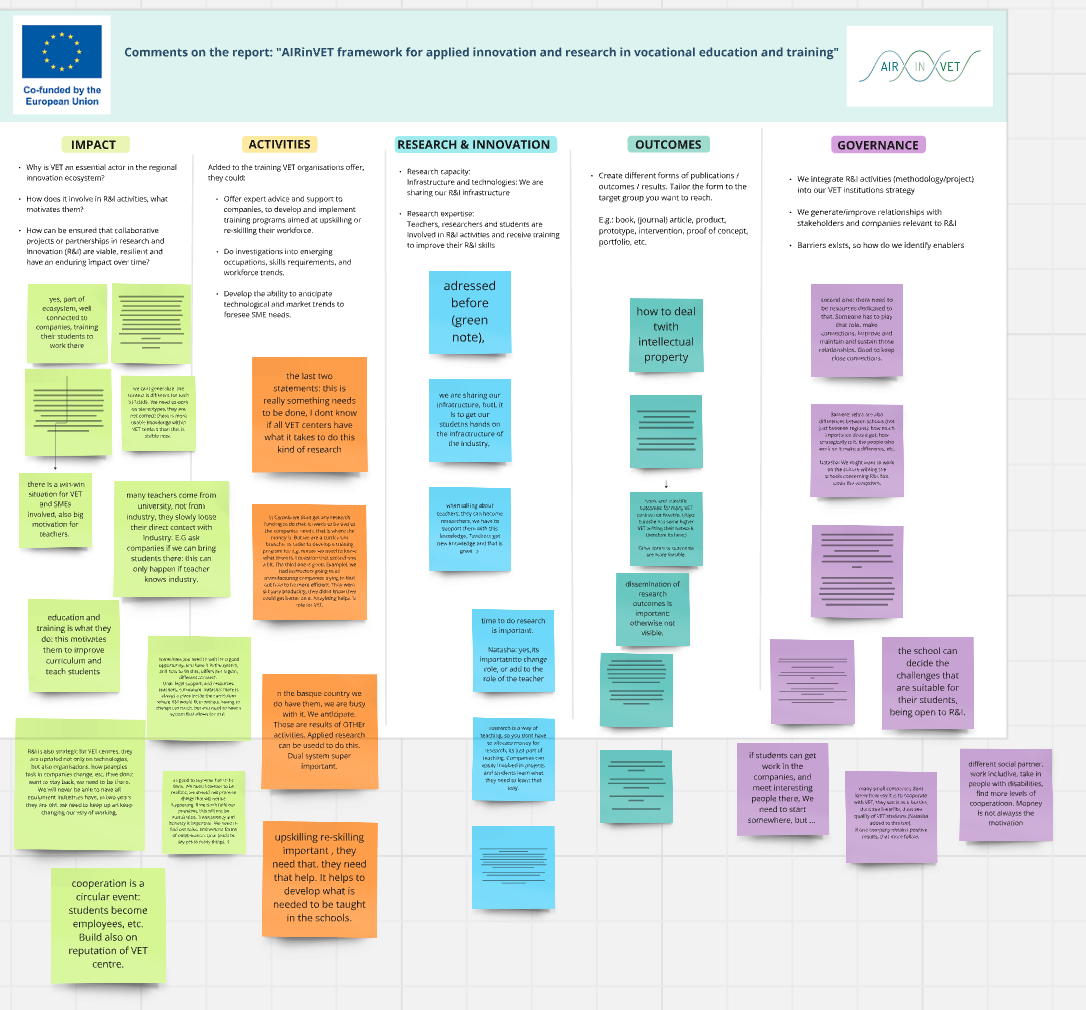Applied Innovation and Research in Vocational Education and Training: Bridging Knowledge and Practice
Applied research in Vocational Education and Training (VET) connects education, innovation, and industry, addressing real-world challenges and aligning with regional economic needs. VET institutions act as bridges between learners and companies, enhancing employability through updated curriculums, internships, and feedback loops. They also contribute to innovation ecosystems via partnerships and collaborative projects, often serving as testbeds for practical solutions. However, challenges like limited resources and systemic barriers persist. Peer review findings highlight opportunities to expand VET’s research capacity, supporting the AIRinVET framework.
Findings from Peer Review Activities
During a group review activity, held on October 15th, as part of the AIRinVET meeting in San Sebastian, feedback was gathered from a group of experts. They represented CIFP Don Bosco LHII, NBCC, and the following European projects: the Challenger Project, the Barcove Project, and the Nearvet Project. Their perspectives provided a multi-dimensional view of how VET institutions engage with applied research and their impact on innovation ecosystems.
The experts involved agreed that VET institutions are integral to regional innovation ecosystems. They noted that VET centres maintain strong connections with companies, where students often transition seamlessly into the workforce. This connection enables VET to play a critical role in bridging educational outcomes with field-specific needs. However, there were differing opinions on how actively VET centres participate in research and innovation (R&I) and whether their projects have long-term viability. While some regions excel in fostering such collaborations, others face systemic barriers. Experts emphasized that the ability to engage in R&I often depends on institutional frameworks, funding availability, and regional priorities.
VET Activities Beyond Training
Discussions revealed that many VET institutions provide expert advice and support to companies, particularly in upskilling and reskilling their workforce. However, conducting research on emerging skills, technological trends, and workforce needs requires additional resources. Some participants highlighted the importance of supporting VET institutions with funding to conduct these activities, as not all centres are equipped with the necessary research capacity. This gap highlights an opportunity to enhance the strategic role of VET in shaping future labour market trends.
Challenges in Research Capacity and Expertise
Experts pointed to critical challenges in expanding research capacity within VET institutions. These include insufficient infrastructure, limited access to advanced technologies, and time constraints for teachers to engage in research. While some participants argued that research expertise can be developed, it is not always feasible for all teachers to take on a dual role as educators and researchers. Others highlighted that research itself can be a powerful teaching tool, enabling teachers to stay updated in their fields and inspire their students with practical, cutting-edge knowledge.

Conclusions
The peer review activity underscored the dual role of VET institutions as educators and contributors to regional innovation ecosystems. This was agreed on by the experts involved, with no debate—it was ‘obvious’ to all participants. While VET is already well-positioned to influence workforce development through training, its potential in applied research remains underutilized in many contexts. Addressing challenges such as limited funding, research infrastructure, and teacher capacity will be key to unlocking this potential.
These conclusions support the AIRinVET framework’s ideas, affirming its focus on enhancing the capacity of VET institutions to engage in research and innovation. Investing in applied research within VET can yield significant benefits: improving curriculums, aligning training programs with future workforce needs, and fostering stronger connections with businesses. By addressing systemic barriers and enhancing institutional support, VET centres can expand their role in research and innovation, becoming essential drivers of sustainable economic and social development.




Subscribe to our newsletter